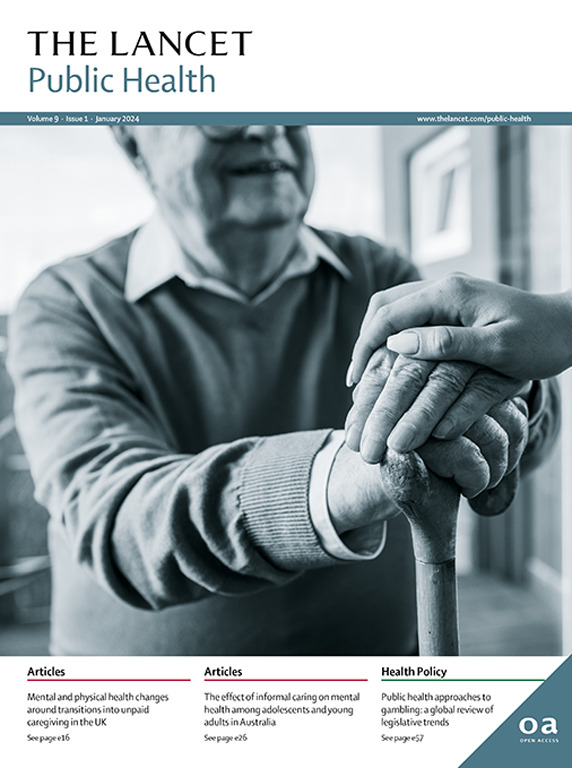Changes in incarceration and tuberculosis notifications from prisons during the COVID-19 pandemic in Europe and the Americas: a time-series analysis of national surveillance data
IF 25.4
1区 医学
Q1 PUBLIC, ENVIRONMENTAL & OCCUPATIONAL HEALTH
引用次数: 0
Abstract
Background
The COVID-19 pandemic disrupted tuberculosis control programmes globally; whether or not this disproportionately affected people who were incarcerated is unknown. We aimed to evaluate changes in incarceration and tuberculosis notifications in prisons in Europe and the Americas during the COVID-19 pandemic.Methods
Data from WHO Pan American Health Organization (PAHO) and WHO Europe were used to conduct a joint hierarchical Bayesian negative binomial time-series. This approach accounted for world region, country-specific temporal trends, and country-specific autocorrelated random effects to simultaneously model and predict both annual prison population (ie, the offset) and prison tuberculosis cases (ie, the primary outcome). Results were used to calculate percentage differences between predicted and observed annual tuberculosis notifications and prison populations during the COVID-19 pandemic years (2020–22).Findings
In total, 22 of 39 countries from PAHO and 25 of 53 countries from WHO Europe were included (representing 4·9 million people incarcerated annually), contributing 520 country-years of follow-up. Observed tuberculosis notifications in prisons were lower than predicted in 2020 (–26·2% [95% credible interval –66·3 to 7·8), 2021 (–46·4% [–108·8 to 3·9]), and 2022 (–48·9 [–124·4 to 10·3]). These decreasing trends were consistent across Europe and the Americas, but larger decreases were seen in low-burden settings in 2020 (–54·8% [–112·4 to –4·8]) and 2021 (–68·4% [–156·6 to –2·9]), high-burden settings in 2021 (–89·4% [–190·3 to –10·4]), and Central and North America in 2021 (–100·3% [–239·0 to –6·3]). Observed incarceration levels were similar to predicted levels (<10% difference overall) during all COVID-19 pandemic years.Interpretation
Tuberculosis notifications in prisons from 47 countries in Europe and the Americas were lower than expected (at times >50% lower) during COVID-19 pandemic years, despite consistent incarceration levels. Reasons for this change in tuberculosis notifications might be multifactorial and include missed diagnoses and implementation of COVID-19 pandemic measures, reducing transmission. Greater prioritisation of people who are incarcerated is needed to ensure appropriate access to care in the face of future pandemics.Funding
Canadian Institutes of Health Research, National Institutes of Health, and Oswaldo Cruz Foundation, Brazil.欧洲和美洲2019冠状病毒病大流行期间监狱监禁和结核病通报情况的变化:对国家监测数据的时间序列分析
COVID-19大流行扰乱了全球结核病控制规划;这是否对被监禁的人产生了不成比例的影响尚不清楚。我们旨在评估2019冠状病毒病大流行期间欧洲和美洲监狱监禁和结核病通报情况的变化。方法采用世卫组织泛美卫生组织(PAHO)和世卫组织欧洲分部的数据,进行联合分层贝叶斯负二项时间序列分析。这种方法考虑了世界区域、特定国家的时间趋势和特定国家的自相关随机效应,从而同时模拟和预测年度监狱人口(即抵消)和监狱结核病病例(即主要结果)。结果用于计算2019冠状病毒病大流行年(2020 - 2022年)预测和观测到的年度结核病通报与监狱人口之间的百分比差异。总共包括了泛美卫生组织39个国家中的22个和世卫组织欧洲53个国家中的25个(每年有490万人被监禁),提供了520个国家-年的随访。2020年(- 26.2%[95%可信区间- 66.3 ~ 7.8])、2021年(- 46.4%[- 108.8 ~ 3.9])和2022年(- 48.9[- 124.4 ~ 10.3])的监狱结核病通报率低于预测。这些下降趋势在整个欧洲和美洲都是一致的,但在2020年低负担地区(- 54.8%[-112·4至-4·8])和2021年(- 68.4%[-156·6至-2·9]),2021年高负担地区(- 89.4%[-190·3至- 10.4])和2021年中北美洲(- 1003%[-239·0至-6·3])下降幅度更大。在所有COVID-19大流行年份,观察到的监禁水平与预测水平相似(总体差异为10%)。在2019冠状病毒病大流行期间,欧洲和美洲47个国家监狱的结核病通报率低于预期(有时低50%),尽管监禁水平保持不变。结核病通报发生这种变化的原因可能是多方面的,包括漏诊和COVID-19大流行措施的实施,从而减少了传播。面对未来的大流行病,需要更加优先考虑被监禁者,以确保获得适当的护理。资助加拿大卫生研究院、美国国家卫生研究院和巴西奥斯瓦尔多·克鲁兹基金会。
本文章由计算机程序翻译,如有差异,请以英文原文为准。
求助全文
约1分钟内获得全文
求助全文
来源期刊

Lancet Public Health
Medicine-Public Health, Environmental and Occupational Health
CiteScore
55.60
自引率
0.80%
发文量
305
审稿时长
8 weeks
期刊介绍:
The Lancet Public Health is committed to tackling the most pressing issues across all aspects of public health. We have a strong commitment to using science to improve health equity and social justice. In line with the values and vision of The Lancet, we take a broad and inclusive approach to public health and are interested in interdisciplinary research.
We publish a range of content types that can advance public health policies and outcomes. These include Articles, Review, Comment, and Correspondence. Learn more about the types of papers we publish.
 求助内容:
求助内容: 应助结果提醒方式:
应助结果提醒方式:


